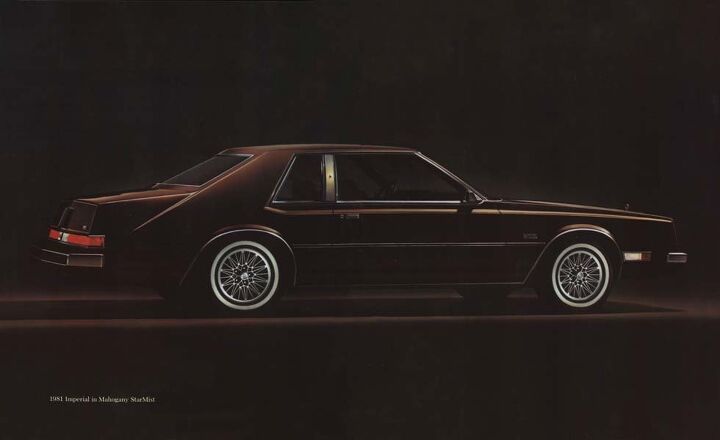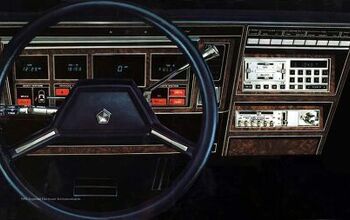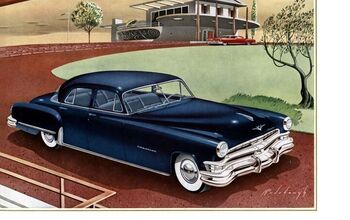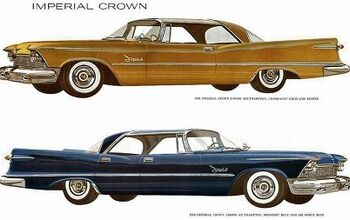Rare Rides Icons: The History of Imperial, More Than Just a Car (Part XVII)

In our last Imperial entry, we found the brand’s run came to an end. In production since 1926 and an independent brand since 1955, the Imperial fizzled out to nothing after 1975. Chrysler closed its luxury Imperial division, and the once proud two- and four-door Imperials were stripped of some standard features and rebranded into the Brougham trim of the New Yorker. The Imperial name had come a long way from its beginnings as a super luxurious coach built car for the wealthy, and ended up as a slightly nicer New Yorker with more formal front and rear clips. But 1975 was not the end of the Imperial’s story, as a particular Chrysler CEO had big Imperial aspirations. To get to that point for Imperial, let’s talk about Ford.
Between the 1976 and 1980 model years, there were no Imperials whatsoever. The most expensive Chrysler one could buy was the New Yorker, and that couldn’t really compete with offerings from Cadillac and Lincoln. We mentioned last time the price and sales chasm between the Imperials and the Cadillac Eldorado, and in particular the Lincoln Continental Mark IV. See, the luxury market was changing in those days, and the PLC (Personal Luxury Coupe) was all the rage. The sedan was no longer the stylish luxury choice, which isn’t too far removed from The Current Year, really.
The top of the PLC pile was the aforementioned Continental Mark IV, which commanded huge money in the Seventies, and cost much more than the Eldorado or the then-extinct Imperial counterpart. The man behind the transformation of the extinct Mark name into a new PLC was Ford president Lee Iacocca. An important force behind cars like the original Mustang and European market Ford Escort, Iacocca helped Ford to turn the unloved fifth generation 1967 Ford Thunderbird (that’s the one that had the Town Landau sedan) into the wildly successful Continental Mark III of 1968.
Continental Mark advanced to the IV in 1972, and continued in its big time PLC success. Said Mark IV was still on sale when Imperial shut down. Though Ford’s profits were big time impressive ($2B in 1977) behind the scenes things were not going so well: Iacocca couldn’t manage to get along with his superior, Henry Ford II. Tensions resulted in Iacocca’s firing in July 1978.
Iacocca found immediate reemployment over at Chrysler, where the struggling company appointed him as CEO. Chrysler’s product needed a do-over, and Iacocca was the man for the job. Particularly appealing on Iacocca’s resume was his success with the Mark III. Chrysler felt he could probably repeat the success of the Mark with a new flagship Imperial, as the company planned to go directly after the Lincoln Mark IV/V. It was Imperial PLC time.
For his part, Iacocca thought that a new flagship would show domestic customers that Chrysler had a promising future, and was no longer circling the drain. Said customers would need to ignore that Iacocca went to the US Congress as newly minted Chrysler chair in 1979, and negotiated a federally guaranteed loan in exchange for much financial streamlining. But surely the Imperial name had enough cachet to carry it off, considering it was a paragon of quality-built luxury a mere 25 years prior.
But what styling does one select for a flagship luxury coupe? Standard Chrysler M-body type looks wouldn’t cut it, so Iacocca went in a bold new direction: a bustleback. The styling trend was something the market hadn’t seen before, and meant to hearken back to the 1940s. It was a time when luxury cars like the Imperial or a Rolls-Royce had long sweeping fenders, and a trunk that looked like it was added on as an extension to the body. The Forties look was itself a callback to the early 20th century, when a trunk was literally a piece of luggage attached to the car. The modern adventure-lifestyle equivalent of this exterior storage is perhaps a Thule roof box.
Cadillac was first to do a bustleback look, which debuted on the new Seville for 1980. Chrysler was second with the new-for-’81 Imperial, and the third and final bustleback was in 1982 when Lincoln introduced the new Fox-body Continental. Though they all featured the same general angular rear styling, the Imperial was the only one that took the rest of the car in a new direction too. The Seville and Continental were both standard type sedan designs, with the bustleback added as an interesting rear end flourish. Iacocca made sure the entire Imperial had a new type of design.
And what a design it was. It didn’t look like anything else on the road in 1981, and was most definitely a bold choice for a new Imperial experiment. The front end featured a large, finely veined waterfall grille, similar in shape to the one found on the last Imperial. The wrap-over grille veining from 1975 was replaced by a blockier chrome top above the grille, like a Lincoln. Carried over were the bumper vents added on the final 1975 version of the Imperial, backed by grille inserts as before. The bumper came to a point in the middle, which was a familiar design queue to any living Imperial customer. Said bumper also wrapped around the front of the fender as before, though implemented a horizontal black trim strip in place of the bump stops of the Seventies.
Headlamps were concealed as they had been previously, though the new Imperial went without Lincoln-style vertical indicator lamps on the fenders. Instead, there were running lamps underneath the headlamps, always visible and generous in proportion. Strong fenders showed almost vertical edges at the front; swept back slightly for a more modern look. Front side parking lamps were of a similar amber and clear design as they were before, and were similar in size to Seventies Imperials. The power dome hood was of its time, and expected on this sort of luxury car.
A strong fender crease was an expectation too. It ran along the body, across the door above the door handle. Though it terminated before the C-pillar, the character line’s placement was similar to the extinct Imperial of the Seventies. There was a secondary character line that ran from below the headlamp and around the wheel well, accented by a rub strip in the middle of the car, and then extended around to the rear tail lamp. Chrome trim was minimal for the time, and was used much more sparingly than in other PLC competition. Aside from the grille, body chrome was limited to window surrounds, mirrors, the aforementioned rub strip, and around the wheel wells. That might sound like a lot, but one can be assured that in 1981 PLC land, it wasn’t. The B-pillar sported an opera lamp, a bit more modern in its interpretation than other opera lamps in period.
Wheels were similarly devoid of chrome, as Iacocca went for a polished snowflake alloy look. The wheels were almost Pontiac-like. In contrast to the traditional white walls, red center caps added a sportier look. For the traditional customer, real wire wheels were also available. They read Imperial on their centers, but were not commonly equipped.
The rear end of Imperial was its defining stylistic feature, and held all the bustleback goodness everyone was so eager to implement at the time. The D-pillar cut at a sharp angle from the roof, and formed a new character line that extended in a very defined way along the rear window, and down the rear 3/4 of the fender. Its terminus was a couple inches before the bumper, where it faded into the sheet metal. The rear bumper was very similar to the one up front, and came to a point in the middle. It wore a similar black trim strip, and was sparing on its chrome usage. The lower half of the bumper was body colored instead of chrome.
The trunk lid itself was prominent, and indeed looked like an add-on (as intended). It was very square, and featured a light rear slope that was less aggressive than the roof character line. there was a crease in the metal down the middle, interrupted by the chromed license plate mounting area. The up high plate location was likely chosen to avoid interrupting the smooth lines of the brake lamp and bumper, as the plate would taken much real estate on either. Underneath the plate were two thin horizontal chrome bands, which encased a full-width brake lamp and its integrated central reverse light. The continuous look was split by a centrally located thin vertical chrome band, and would have looked much better without.
Iacocca went for independent branding once more with the Imperial, which was signified by a distinct lack of badges. There was a Chrysler Pentastar up front, Imperial script badging behind the front wheels, and a small Imperial badge on the back. Chrysler appeared nowhere on the car. Marketing said simply, “Imperial.”
Though it was an all-new design outside, the stuff underneath and inside the Imperial was much less special than the exterior. And those two things were just the start of the coupe’s problems. We’ll get into that next time.
[Images: Chrysler]

Interested in lots of cars and their various historical contexts. Started writing articles for TTAC in late 2016, when my first posts were QOTDs. From there I started a few new series like Rare Rides, Buy/Drive/Burn, Abandoned History, and most recently Rare Rides Icons. Operating from a home base in Cincinnati, Ohio, a relative auto journalist dead zone. Many of my articles are prompted by something I'll see on social media that sparks my interest and causes me to research. Finding articles and information from the early days of the internet and beyond that covers the little details lost to time: trim packages, color and wheel choices, interior fabrics. Beyond those, I'm fascinated by automotive industry experiments, both failures and successes. Lately I've taken an interest in AI, and generating "what if" type images for car models long dead. Reincarnating a modern Toyota Paseo, Lincoln Mark IX, or Isuzu Trooper through a text prompt is fun. Fun to post them on Twitter too, and watch people overreact. To that end, the social media I use most is Twitter, @CoreyLewis86. I also contribute pieces for Forbes Wheels and Forbes Home.
More by Corey Lewis
Latest Car Reviews
Read moreLatest Product Reviews
Read moreRecent Comments
- Lorenzo I'd actually buy another Ford, if they'd bring back the butternut-squash color. Well, they actually called it sea foam green, but some cars had more green than others, and my 1968 Mercury Montego MX was one of the more-yellow, less-green models. The police always wrote 'yellow' on the ticket.
- ToolGuy Some of my first cars were die-cast from pot-metal in 2 pieces: body-in-white plus chassis. I spray-painted some of them, the masking was a pain. The tires did burn realistically.
- Vulpine Tesla has NOT said they're scrapping the Gigacasting process, but they have also said they wouldn't cast a one-piece body. The concept is to have a total of 5 main pieces: Nose clip, tail clip, 2 sides and belly. They're already using the first two and the sides are not necessarily going to be castings. The belly casting, however, is being delayed as the battery technologies are changing far too quickly to lock into any one fixed design as the battery packs themselves are currently consisting of at least three different types based on the cells being used within them. It's a matter of convenience for the company to let the technologies stabilize somewhat before locking in on a specific design.
- MaintenanceCosts I've never prioritized color when looking for a car, but there are usually some colors (particularly bright reds and refrigerator whites) that I just won't accept.That said, one of my cars gets parked outside in a city environment, and it's silver, and that's good because silver does not complain too much when oxidized to he!l. The brown BMW is neat because there aren't many brown BMWs, and the green Legend is historically correct because the mid-'90s meant green.
- ToolGuy • Black vehicles and dark interiors burn more petrol and are bad for the planet (look it up, I'm not gonna hold your hand on this one lol).• If your current vehicle was new when you took delivery, and you didn't get EXACTLY the color you wanted (blithely accepted what was foisted on you by the dealer), shame on you. You are the problem with today's franchise system. In future, please notify the dealer that your policy is to collect a Non-First-Choice Paint Upcharge in such a circumstance. I recommend $1200.• Also, fine-thread drywall screws (in wood) waste electricity (and time). When I am President of the Universe, fine-thread drywall screws will be banned in favor of the more environmentally- and wallet-friendly coarse-thread variety. (Again, you can work out the reasons but I am absolutely correct.)









































Comments
Join the conversation
That might be part of it but Chrysler had some very cheap hardware on their vehicles and the electrics were sub par. Had some real problems with the power windows and locks on my mother's 5th Avenue along with door straps and handles falling off. It's a shame because much of the drive train was really good and their engineering was some of the best of any auto company. Chrysler had some great engines.
XVII Imperial entries so far and not a single Star Wars reference in the comments? Disappoint.